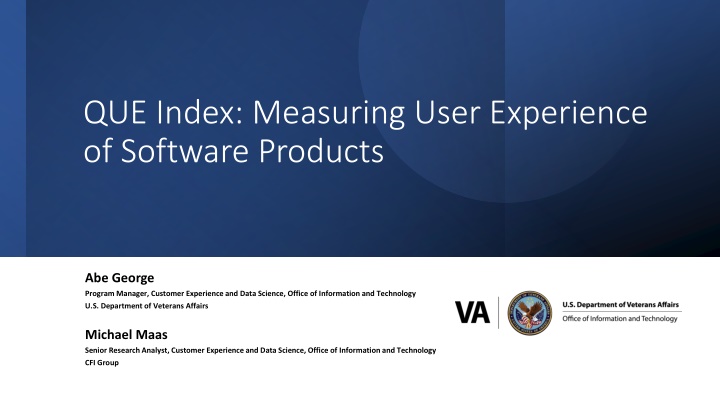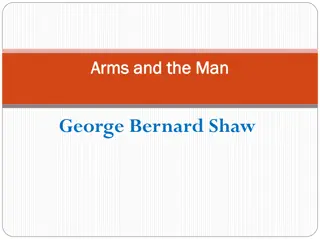
Measuring User Experience of Software Products and Websites
"Learn about methodologies to measure user experience of software products and websites, including Net Promoter Score, Customer Effort Score, and System Usability Scale. Discover the importance of quality, usability, and efficiency factors for product success."
Download Presentation

Please find below an Image/Link to download the presentation.
The content on the website is provided AS IS for your information and personal use only. It may not be sold, licensed, or shared on other websites without obtaining consent from the author. If you encounter any issues during the download, it is possible that the publisher has removed the file from their server.
You are allowed to download the files provided on this website for personal or commercial use, subject to the condition that they are used lawfully. All files are the property of their respective owners.
The content on the website is provided AS IS for your information and personal use only. It may not be sold, licensed, or shared on other websites without obtaining consent from the author.
E N D
Presentation Transcript
QUE Index: Measuring User Experience of Software Products Abe George Program Manager, Customer Experience and Data Science, Office of Information and Technology U.S. Department of Veterans Affairs Michael Maas Senior Research Analyst, Customer Experience and Data Science, Office of Information and Technology CFI Group
Objective Measure user experience of software products and websites on factors that are most important for a product s success. Product Success Factors Quality: Functioning of the product Usability: Easiness of learning and using it Efficiency: How the product impacts the efficiency of the user s work 2
Common Methodologies: Net Promoter Score ADVANTAGES DISADVANTAGES Use of a single question: How likely is it that you would recommend Product X to a friend or colleague? Follow-up open-ended question for detailed feedback Most popular methodology Not applicable within government and other places where product choices are restricted Score calculation considers only promoters and detractors and ignores the passives Overall score cannot be split into attribute scores 3
Common Methodologies: Customer Effort Score ADVANTAGES DISADVANTAGES Use of a single question on customer effort Measures the effort customer had to exert to use a product or get a service May follow-up with open-ended question for detailed feedback Measures only the effort customer had to exert to use a product or get a service Overall score cannot be split into attribute scores 4
Common Methodologies: System Usability Scale ADVANTAGES DISADVANTAGES Has been in use for several years Used in government and industries Ten questions Multiple questions appear similar Cannot get scores for individual product attributes 5
QUE Index: A New Measure Quality: Functioning of the product Product X functions in a high-quality and responsive manner. Usability: Easiness of learning and using it Product X is easy for me to learn and use. Five-point Likert Scale Questions 1 (Strongly disagree) to 5 (Strongly agree) Efficiency: How the product impacts the efficiency of the user s work Product X helps me to work more efficiently to achieve my goals. Open-Ended Question (optional) Please explain the reasons for the ratings you have given above 6
Calculations Item Scores and QUE Index will range from 20 to 100 QUE Index = Weighted average (Quality Score, Usability Score, Efficiency Score) Item Score = ((% Strongly Disagree x 1) + (% Disagree x 2) + (% Neither disagree nor agree x 3) + (% Agree x 4) + (% strongly agree x 5)) /5 QUE Index Value Product Assessment 80 to 100 Excellent 70 to < 80 Very Good 60 to < 70 Acceptable, Need Improvement 50 to < 60 Poor, Need Improvement Below 50 Unacceptable 8
Applications and Uses Baseline Measurement and Trend Analysis Product Maturity Analysis Requirements Gathering for Product Improvement Return on Investment Analysis 9
Appendix-1 System Usability Scale (SUS) Questions: 1. I think that I would like to use this Product X frequently. 2. I found the Product X unnecessarily complex. 3. I thought the Product X was easy to use. 4. I think that I would need the support of a technical person to be able to use this Product X. 5. I found the various functions in this Product X were well integrated. 6. I thought there was too much inconsistency in this Product X. 7. I would imagine that most people would learn to use this Product X very quickly. 8. I found the Product X very cumbersome to use. 9. I felt very confident using the Product X. 10. I needed to learn a lot of things before I could get going with this Product X. 10

![❤[PDF]⚡ Civil War Talks: Further Reminiscences of George S. Bernard and His Fel](/thumb/20551/pdf-civil-war-talks-further-reminiscences-of-george-s-bernard-and-his-fel.jpg)
![❤Book⚡[PDF]✔ Doing the Impossible: George E. Mueller and the Management of NASA’](/thumb/21684/book-pdf-doing-the-impossible-george-e-mueller-and-the-management-of-nasa.jpg)



















